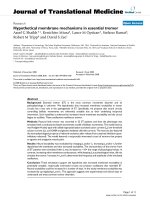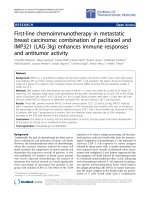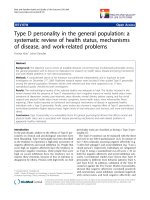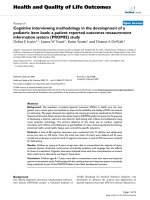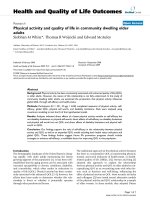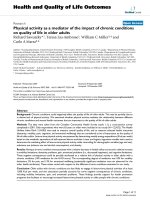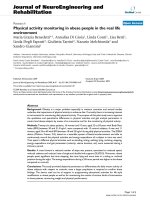báo cáo hóa học: "Physical activity monitoring in obese people in the real life environment" pot
Bạn đang xem bản rút gọn của tài liệu. Xem và tải ngay bản đầy đủ của tài liệu tại đây (217.18 KB, 9 trang )
BioMed Central
Page 1 of 9
(page number not for citation purposes)
Journal of NeuroEngineering and
Rehabilitation
Open Access
Research
Physical activity monitoring in obese people in the real life
environment
Maria Grazia Benedetti*
1
, Annalisa Di Gioia
1
, Linda Conti
1
, Lisa Berti
1
,
Linda Degli Esposti
2
, Giulietta Tarrini
2
, Nazario Melchionda
2
and
Sandro Giannini
1
Address:
1
Movement Analysis Laboratory, Istituto Ortopedico Rizzoli, University of Bologna, Italy and
2
Unit of Metabolic Diseases, Clinical
Medicine Department, University of Bologna, Italy
Email: Maria Grazia Benedetti* - ; Annalisa Di Gioia - ; Linda Conti - ;
Lisa Berti - ; Linda Degli Esposti - ; Giulietta Tarrini - ;
Nazario Melchionda - ; Sandro Giannini -
* Corresponding author
Abstract
Background: Obesity is a major problem especially in western countries and several studies
underline the importance of physical activity to enhance diet. Currently there is increasing interest
in instruments for monitoring daily physical activity. The purpose of this pilot study was to appraise
the qualitative and quantitative differences in physical activities and gait analysis parameters in
control and obese subjects by means of an innovative tool for the monitoring of physical activity.
Methods: Twenty-six obese patients, 16 women and 10 men, aged 22 to 69 years with Body Mass
Index (BMI) between 30 and 51.4 kg/m
2
, were compared with 15 control subjects, 4 men and 11
women, aged 24 to 69 with BMI between 18 and 25 kg/m
2
during daily physical activities. The IDEEA
device (Minisun, Fresno, CA), based on a wearable system of biaxial accelerometers and able to
continuously record the physical activities and energy expenditure of a subject in time was used.
Time spent in different physical activities such as standing, sitting, walking, lying, reclining, stepping,
energy expenditure and gait parameters (velocity, stance duration, etc) were measured during a
24-hours period.
Results: A trend toward a reduced number of steps was present, associated to reduced speed,
reduced cadence and reduced rate of single and double limb support (SLS/DLS). Moreover, obese
people spent significant less time stepping, less time lying and more time in a sitting or reclined
position during the night. The energy expenditure during a 24-hours period was higher in the obese
compared to controls.
Conclusions: The study provided objective parameters to differentiate the daily motor activity of
obese subjects with respect to controls, even a larger population is required to confirm these
findings. The device used can be of support in programming educational activities for life style
modification in obese people as well as for monitoring the results of various kinds of intervention
in these patients concerning weight and physical performance.
Published: 30 December 2009
Journal of NeuroEngineering and Rehabilitation 2009, 6:47 doi:10.1186/1743-0003-6-47
Received: 8 April 2009
Accepted: 30 December 2009
This article is available from: />© 2009 Benedetti et al; licensee BioMed Central Ltd.
This is an Open Access article distributed under the terms of the Creative Commons Attribution License ( />),
which permits unrestricted use, distribution, and reproduction in any medium, provided the original work is properly cited.
Journal of NeuroEngineering and Rehabilitation 2009, 6:47 />Page 2 of 9
(page number not for citation purposes)
Background
A large amount of data are available on the relationship
between physical activity and obesity [1-4]. In particular
the National Institute of Health, in the "Clinical Guide-
lines on the Identification, Evaluation and Treatment of
Overweight and Obesity in Adults" [1] highlights the
importance of physical activity in weight loss. Physical
activity increases energy expenditure, inhibits the sense of
hunger, helps in maintaining optimal weight and reduces
the risk of cardio-vascular disease. Guidelines also high-
light the importance of the association of physical activity
with diet, because it allows greater weight loss and greater
BMI reduction than diet alone. Finally, the improvement
of cardio-respiratory fitness and the reduction of cardio-
vascular risk brought about by physical activity, inde-
pendently of weight loss is emphasized.
In 2006 the Cochrane Library published a review [4] that
underlined, through the meta-analysis of 43 studies, that
physical exercise, especially high-intensity exercise, associ-
ated with diet is more effective than diet alone not only in
determining weight loss, but also in decreasing the risk of
cardiovascular disease.
Thus it is easy to understand the increasing interest in the
development of tools able to monitor physical activity
and reflect the complexity of human activities in daily life
conditions.
Nowadays, the most commonly used methods for the
measurement of daily physical activity are questionnaires,
like the Physical Activity Scale for Elderly (PASE) [5], the
NUGENOB study [6], the Baecke Questionnaire [7] and
the International Physical Activity Questionnaire (IPAQ)
[8]. Several studies have confirmed the validity and relia-
bility of such questionnaires, by showing that their scores
are related to the real daily physical activity of the subject.
However, other authors underline the limits of such ques-
tionnaires, because they are strictly linked to the subjectiv-
ity of the evaluation - patients often tend to over-estimate
the intensity or the duration of their own activity [9] - and
to the lack of international standards to define the con-
cept of "physical activity" and its intensity [10].
Moreover, technology currently offers numerous tools to
measure objectively the level of physical activity (type,
time, intensity, ) performed by the subject during daily
life or the daily energy expenditure, or even to associate
these two measurements. Among the most widely used
instruments are of course accelerometers (mono-, bi- or
tri-axial), pedometers, gyroscopes, and heart rate moni-
tors [11-13].
The aim of this pilot study was to compare the daily phys-
ical activity of a group of obese subjects with the daily
physical activity of a group of control subjects. For this
purpose an advanced wearable device, IDEEA, was used. It
provides information about motor activities with regards
to type and duration, gait parameters and energy expend-
iture and has been previously reported to be very accurate
in adults [14-21].
Methods
Subjects
Twenty-six volunteer obese patients were enrolled on a
voluntary basis from a wider group of subjects treated at
the Department of Metabolism Disease of the University
of Bologna (Italy). Sixteen were women and 10 men, aged
22 to 69 with a Body Mass Index (BMI) of between 30 and
51.4 kg/m
2
. Exclusion criteria were severe cardiovascular
diseases and neurological impairment. The occupation of
the obese subjects was as follows: employees n.11, nurses
n.2, housewives 2, sales agent n.2, student n.2, retired n.2,
truck driver n.1, worker n.1, bartender n.1, sales represent-
ative n.1, warehouse worker n.1.
Fifteen control subjects, 4 men and 11 women, aged 24 to
69 with a BMI of between 18 and 25 kg/m
2
were recruited
(Table 1). Control subjects were on a voluntary base were
enrolled among acquaintances and staff of the participat-
ing institutions, based on their BMI, on the absence of any
known pathology and on their normal life style (no pro-
fessional sports). Their current occupation was as follows:
students n.5, physicians n.4, engineers n.3, physical ther-
apist n.1, employee n.1, assistant researcher n.1.
All subjects included were asked to spend the day per-
forming all the usual activities both relative to their occu-
pation and normal activities of daily life.
Table 1: Characteristics of subjects
Age Range
(yrs)
Mean age
(yrs)
Sex Height
Range
(cm)
Mean
height
(cm)
Weight
Range
(kg)
Mean
weight
(kg)
BMI Range
(kg/m
2
)
Mean BMI
(kg/m
2
)
Norm (n.15) 24-69 45 11 F
4 M
155-186 168.8 47-97 61.8 18-25 21.33
Obese (n.26) 22-69 47,5 16 F
10 M
150-181 164.6 78-136 97.15 30-51.44 35.77
Journal of NeuroEngineering and Rehabilitation 2009, 6:47 />Page 3 of 9
(page number not for citation purposes)
Informed consent was signed by all the subjects and the
study was approved by the Ethical Committee of the
project leader's Institute.
Monitoring physical activity
IDEEA (Minisun, Fresno, CA) was used to measure energy
expenditure and monitor physical activity. It is an inte-
grated portable system, composed of a recording device
(IDEEA data recorder, weighing 200 g, with a 33 MHz, 32
bit microprocessor) that allows the acquisition, process-
ing and compression of data in real time - connected to 5
small DC coupled accelerometers (16 × 14 × 6 mm), that
measure the angle between body segments and their accel-
eration on two planes, with a data acquisition frequency
of 32 Hz (0,3 measures/s). For communication between
the PC and the IDEEA recorder, the software allows data
to be downloaded on the PC, which can be processed and
visualized through the Act View program.
IDEEA provides information about different physical
activities (standing, sitting, walking, lying, reclining, step-
ping, etc), walking speed, and energy expenditure pro-
duced during activities (EE - measured in kcal/min or kJ/
min or Watts). The ability of IDEEA to appraise the energy
expenditure under daily life conditions depends on its
capacity to identify type and intensity of the activity devel-
oped and to connect these parameters with a series of
equations for measuring energy expenditure for each
activity.
The tool also provides gait analysis data, by identifying
step and stride length, velocity, cadence, stance, swing and
double support duration and visualizing the results
through graphs and charts. Other parameters provided by
the instruments are the "pulling acceleration", defined as
the maximum linear acceleration of the foot during the
initial swing phase, the "swing power", defined as the
maximum deceleration during the mid and terminal
phases of swing, and the "ground impact", defined as the
maximum deceleration in a vertical direction during the
loading acceptance [22].
Both control and obese subjects wore the IDEEA: sensors
were positioned under the plantar arch of each foot, two
on the anterior part of each thigh and one on the sternum,
all fixed to the skin by a hypoallergenic adhesive tape. The
tool was then connected to the PC, and the subject's
anthropometric data were entered. At the end of this
phase, the subject sat with the trunk in a vertical position,
and feet and knees parallel to the floor (angles formed by
hip, knee and ankle were 90°). In this position the device
was calibrated according to the manufacturer's instruc-
tions [13]. After that the tool was disconnected from the
computer and the patients were asked to lead their usual
life for the following 24 hours and return the next day to
download and process data.
Statistic analysis
Statistical analysis was performed using the Mann Whit-
ney test (p < 0.05) for non-parametric data with different
variance.
Results
Motor activity
Considering all the physical activities, the obese subjects
covered 4.63 ± 2.22 km (range 0,69-9,54 km) within the
24 hours, while control subjects covered 7.00 ± 3.81 km
(range 2.93-14.80 km) (p = 0.09) (Table 2). Concerning
the time spent in different physical activities, both in
terms of percentage and absolute time, no significant dif-
ference between the two groups, either for walking or
standing was found.
Obese subjects spent 0.29 ± 0.35% of the time in stepping
(range 0.04-1.37%, corresponding to 2.94 ± 2.39 min
(range 0.56-11.0 min), while control subjects spent 0.54
± 0.52% (range 0.15-2.26%) of the time, corresponding
to 5.54 ± 4.72 min (range 1.18-12.80 min) (p = 0, 05, p =
0,03).
Even data about lying, sitting and reclining postures were
not significantly different, when we considered only the
night time hours (from 11:00 pm to 7:00 am), differences
among the two groups were found (Table 3). The supine
position was preferred by control subjects, with a percent-
age of 57.71 ± 22.74% (range 14.84-93.49%) against the
41.53 ± 27.38% (range 2.5-93.88%) of obese patients (p
= 0.06). However no significant differences in the percent-
ages of night time spent sitting or reclining between the
two groups was found.
Time-distance parameters of gait
The number of steps walked during the 24 hours was not
significantly different in the two groups even a trend
toward a reduced number of steps was evident in the
obese group (5870.15 ± 2693.95 vs 7859.27 ± 4596.0 for
the controls) (Table 4). Data about the total duration of
the walk were not significant but even in this case a trend
toward reduction in the obese subjects is evident 69.15 ±
25.80 min vs 84.13 ± 42.84 min for controls) - likewise
for the distances covered walking (4.73 ± 2.53 km vs 5.90
± 3.47 km for controls).
As for the different phases of the walk, we did not find dif-
ferences in step or stride length. Step length had a mean
value of 1.64 ± 0.75 m and stride length had a value of
0.82 ± 0.37 m in obese subjects. Values for the controls
were very similar, with a step length of 1.81 ± 0.53 m and
a stride length of 0.90 ± 0.26 m.
Journal of NeuroEngineering and Rehabilitation 2009, 6:47 />Page 4 of 9
(page number not for citation purposes)
No differences were found for the swing phase duration:
433.54 ± 104.73 ms for controls and 409.47 ± 71.57 ms
for obese subjects.
The difference in cadence between the two groups (p =
0.05) was statistically significant: for the obese patients in
fact we found a cadence of 93.11 ± 20.11 step/min, while
for controls it was 104.18 ± 10.06 step/min. Conse-
quently, even the difference in walking speed was signifi-
cantly different (p = 0.04), measuring 66.04 ± 19.83 m/
min for obese subjects and 79.32 ± 19.44 m/min for con-
trols. It follows that stride cycle duration was significantly
different (p = 0.036): 1.12 ± 0.09 s for controls and 1.18
± 0.07 s for obese subjects.
A highly statistical difference was found in the rate of sin-
gle and double limb support during the stride cycle (SLS/
DLS) (p < 0.0005): 241.76 ± 37.08 for the obese subjects
and 315.74 ± 50.16 for controls. Nevertheless, consider-
ing separately the duration of the single limb support
(SLS) and the double limb support (DLS), only a trend
toward reduction for the former and an increasing for the
latter were found in the obese subjects with respect to con-
trols, no statistically significant (Table 4).
Table 2: Time spent in physical activities
(%) (min) Mann Whitney
Min. Mean ± SD Max. Min. Mean ± SD Max % min
Lie Norm (n.26) 5.50 23.24 ± 9.24 35.90 74.30 327.10 ± 127.79 506.30 NS NS
Obese (n.15) 0.09 18.43 ± 12.24 44.70 1.20 263.31 ± 174.06 637.40
Recline Norm (n.26) 0.96 8.51 ± 6.70 26.67 13.80 119.94 ± 95.08 384.30 NS NS
Obese (n.15) 0.46 11.93 ± 8.79 31.83 6.70 184.86 ± 135.86 452.50
Sit Norm (n.26) 24.37 39.88 ± 10.33 60.76 355.40 562.30 ± 144.55 820.50 NS NS
Obese (n.15) 12.29 43.45 ± 12.78 71.76 172.20 621.20 ± 181.62 1033.8
Stand Norm (n.26) 15.13 21.53 ± 4.89 32.03 210.80 305.04 ± 75.48 461.3 NS NS
Obese (n.15) 11.09 20.58 ± 7.73 39.23 158.60 294.32 ± 110.99 569.9
Walking Norm (n.26) 2.49 5.61 ± 2.83 11.75 34.60 79.74 ± 41.64 171.40 NS NS
Obese (n.15) 0.9 4.55 ± 1.77 7.79 12.60 65.15 ± 25.31 109.20
Step Norm (n.26) 0.15 0.54 ± 0.52 2.26 1.18 5.54 ± 4.72 12.80 p = 0,05 p = 0,03
Obese (n.15) 0.04 0.29 ± 0.35 1.37 0.56 2.94 ± 2.39 11.00
Table 3: Percentage of time spent lie or recline during the night *
Lie
(%)
Reclined
(%)
Sitting
(%)
Min Mean ± SD Max Min Mean ± SD Max Min Mean ± SD Max
Norm (n.15) 14.84 57.71 ± 22.74 93.49 0.07 15.16 ± 14.06 41.18 1.78 22.96 ± 14.52 49.07
Obese (n.26) 2.5 41.53 ± 27.38 93.88 0.16 20.72 ± 20.84 83.26 1.77 31.50 ± 22.85 94.01
Mann Whitney p = 0.05 NS NS
* from 11.00 pm to 7.00 am
Journal of NeuroEngineering and Rehabilitation 2009, 6:47 />Page 5 of 9
(page number not for citation purposes)
Table 4: Time distance parameters
Mean ± SD Min Max Mann Whitney
Steps Norm (n.15) 7859,27 ± 4596.0 2177 17685 NS
Obese (n.26) 5870.15 ± 2693.95 1102 11563
Duration (min) Norm (n.15) 84.13 ± 42.84 35 180 NS
Obese (n.26) 69.15 ± 25.80 15 112
Distance (km) Norm (n.15) 5.90 ± 3.47 0.39 12 NS
Obese (n.26) 4.73 ± 2.53 0.71 12.9
Stride Length (m) Norm (n.15) 1.81 ± 0.53 1.2 3.0 NS
Obese (n.26) 1.64 ± 0.75 1.2 5.2
Step Length (m) Norm (n.15) 0.90 ± 0.26 0.62 1.48 NS
Obese (n.26) 0.82 ± 0,37 0.58 2.59
Swing (ms) Norm (n.15) 433.54 ± 104.73 375.00 798.5 NS
Obese (n.26) 409.47 ± 71.57 346.80 720.9
Step (ms) Norm (n.15) 553.22 ± 57.97 493.70 739.0 NS
Obese (n.26) 590.95 ± 76.65 517.5 929.6
Cycle duration (s) Norm (n.15) 1.12 ± 0.09 1.00 1.36 p = 0.036
Obese (n.26) 1.18 ± 0.07 1.05 1.32
Cadence (steps/min) Norm (n.15) 104.18 ± 10.06 82.0 119.40 p = 0.05
Obese (n.26) 93.11 ± 20.11 8.10 112.00
Speed (m/min) Norm (n.15) 79.32 ± 19.44 61.20 141.6 p = 0.04
Obese (n.26) 66.04 ± 19.83 44.4 150.5
Single Support (ms) Norm (n.15) 433.54 ± 104.73 375.0 798.5 NS
Obese (n.26) 409.47 ± 71.57 346.80 720.9
Double Support (ms) Norm (n.15) 156.60 ± 68.63 96.10 393.4 NS
Obese (n.26) 187.68 ± 57.9 131.20 420
SLS/DLS (%) Norm (n.15) 315.74 ± 50.16 211 441.30 p < 0.0005
Obese (n.26) 241.76 ± 37.08 172.2 304.20
Pulling Accel (G) Norm (n.15) 0.62 ± 0.39 0.21 1.86 NS
Journal of NeuroEngineering and Rehabilitation 2009, 6:47 />Page 6 of 9
(page number not for citation purposes)
No significant differences were found also in the duration
of a single footstep: 553.22 ± 57.97 ms for controls versus
590.95 ± 76.65 ms for the obese. Neither the Pulling
Acceleration nor the Swing Power and the Ground Impact
showed significant differences between the two groups.
Finally, we noticed a significant reduction in the pre-
swing angle in the obese subjects in comparison with the
controls (p = 0.03). This value was 37.54 ± 18.02 degrees
in the obese subjects against 50.14 ± 15.31 degrees in the
controls.
Energy expenditure
With regards to energy expenditure, the average (p =
0.007), total (p = 0.02), least (p < 0.0005) and maximum
(p = 0.046) were significantly greater in the obese subjects
than in the controls.
In the controls the average energy expenditure was 1.78 ±
0.27 kcal/min and the total was 2525.5 ± 427.63 kcal/
min, which is therefore significantly lower in comparison
to those found in obese patients, which were 2.30 ± 0.66
kcal/min as average energy expenditure and 3027.09 ±
731.09 kcal as total energy expenditure. As for the least
energy expenditure the obese patients had values of 1.38
± 0.18 kcal/min against 1.12 ± 0.21 kcal/min in controls.
Finally, the maximum energy expenditure was 16.41 ±
4.68 kcal/min in the obese patients, and 13.48 ± 3.73
kcal/min in controls.
Discussion
Daily physical activities have a fundamental role in all
therapeutic approaches to obesity to reach a state of fit-
ness, and adequate instruments to assess it objectively and
reliably are required.
Different studies support the validity and reliability of the
instrument we used (IDEEA - Minisun, Fresno, CA), to
measure gait analysis parameters and energy expenditure
both in healthy and unhealthy subjects, having been
tested in hemiparetic subjects [18], patients with arthritic
knee [22], minimally invasive total hip arthroplasty [23],
high-flex total knee replacement [24], elderly [25] and
children with cerebral palsy [26,27]. As the first step we
considered it appropriate to compare gait analysis data,
obtained in the present study for control subjects by
means of the IDEEA device, with the literature. Table 5
shows data from available studies. Control data in the
present study seem to compare well with the few previous
findings on healthy people even if the number of subjects
and the number of steps performed are greater in our
study. However, we found a wide variability both in the
controls and in the obese subjects, which is difficult to
compare to the other studies. The only long-term moni-
toring study [18], reports a wide variability in the number
of steps walked but unfortunately it does not present val-
ues relevant to specific measurements. The large variance
might account for the fact that even if most of the param-
eters detected were different in the two populations, only
a few were statistically significant, particularly for gait
analysis. This can be considered as a statistical limitation
of this pilot study which should be confirmed on a larger
sample of both obese and control subjects. In this respect
moreover a previous study on the reliability of the system
[19] warns about the need to record a steady state ambu-
lation outside a laboratory, which is a necessary condition
for the validity of gait data.
In the present study, even a trend in reduced time spent in
walking and standing was present as well as an increasing
in time spent sitting and a reduction in number of steps
walked, these data showed large variance and were not
significantly different in the two groups. Obese subjects
conversely spent significant less time stepping and walked
with reduced speed related mainly to reduced cadence,
and reduced rate of single and double limb support (SLS/
DLS). These findings are in agreement with the data previ-
ously reported on gait in obese people by means of opto-
electronic systems [28,29]. The greater tendency in obese
subjects to be sedentary can be explained by looking at the
Obese (n.26) 0.63 ± 0.17 0.35 0.92
Swing Power (G) Norm (n.15) 0.95 ± 0.18 0.73 1.32 NS
Obese (n.26) 0.90 ± 0.20 0.54 1.49
Ground Impact (G) Norm (n.15) 1.31 ± 0.17 0.92 1.53 NS
Obese (n.26) 1.21 ± 0.34 0.05 1.82
Pre swing angle (deg) Norm (n.15) 50.14 ± 15.31 23.0 72.5 p = 0.03
Obese (n.26) 37.54 ± 18.02 9.7 73.7
Table 4: Time distance parameters (Continued)
Journal of NeuroEngineering and Rehabilitation 2009, 6:47 />Page 7 of 9
(page number not for citation purposes)
results of daily energy expenditure. In fact, both the aver-
age and the total values of energy expenditure were signif-
icantly greater in obese subjects, and probably this greater
energetic demand makes the obese subject to leading a
less active life reinforcing a vicious circle. Also this finding
is in agreement with data in the literature, which show
that average energy expenditure is significantly higher in
obese people, resulting from an increase in the energy cost
of both basal metabolism and physical activity [30-32].
The assessment of nighttime postures is worth of atten-
tion as results showed that obese patients spent more time
sitting or reclining instead of lying. Previous work on the
reliability of the IDEEA device in detecting position
showed that the reclining posture is one of the measures
most subject to error for correct identification due to ana-
tomical differences among subjects [13,26]. The align-
ment of trunk sensors is, in fact, crucial to distinguish
between sitting, reclining and lying down. Even if this
could be the case of obese people where the anatomy of
the trunk could lead to a critical detection, we feel that this
could be more related to the distinction between the sit-
ting and the reclining positions than to the lying position.
In fact, direct interview to the patients revealed that most
obese subjects had the habit of sleeping with more pillows
because of the better respiratory dynamics achievable in
that position [33]. There is evidence in fact that the raised
position favors diaphragmatic work and limits the fat
pressure on the hypopharynx, thus decreasing the fre-
quency of apnea during sleep and allowing the expansion
of the rib cage [34]. Nevertheless, as we did not ask sub-
jects to keep a log of their activities, we can consider the
interpretation of findings from the present work just as an
hypothesis as we do not know exactly if the obese subjects
stayed up late or get up early for work or other reasons and
therefore spent less time in a supine position during the
night hours.
The IDEEA device was very easy to assemble and calibrate.
Although sometimes very obese people had some discom-
fort as the cabled sensors were tightened, none of the sub-
jects included in the study reported any problem of
detachment of sensors or problems with the device during
the monitoring period. The main limitation of the device
reported by the subjects was the impossibility to have a
bath or a shower. This could be critical particularly when
activity has to be monitored over periods longer than 24
hours. At the beginning of the present study our purpose
was to assess patients before and after a program of cogni-
tive-behavioral treatment for obesity. However, when we
Table 5: Comparison of data from literature
Parameters Present study Huddleston et al 2006 Saremi et al 2006 Maffiulletti et al 2008
15 healthy age ranged
24-69 yrs, 9173.58 ±
386.79 steps
5 healthy, 43.8 ± 14.5
yrs, 8441 ± 4785 steps
1 healthy, 56 yrs, 10
steps
10 healthy, 34 ± 11 yrs, 4-5
steps for each trial, 9-12 trials
for individual subjects
Stride Length (m) 1.81 ± 0.53 1.56 ± 0.05 L 1.441 ± 0.133
R 1.427 ± 0.149
Step Length (m) 0.90 ± 0.26 0.78 ± 0.03 L 0.715 ± 0.068
R 0.714 ± 0.083
Swing (msec) 433.54 ± 104.73 397 ± 14.7
Cycle (s) 1.12 ± 0.09 0.99 ± 0.02
Cadence (steps/min) 104.18 ± 10.06 120 ± 3.88 116.6 ± 9.8
Speed (m/min) 79.32 ± 19.44 11.7 ± 4.5 94.0 ± 2.9 1.38 ± 0.14 m/sec
(82.80 m/min)
SLS (msec) 433.54 ± 104.73 397 ± 14.7 L 420.3 ± 28.7
R 419.5 ± 22.7
DLS (msec) 156.60 ± 68.63 103 ± 14.7
SLS/DLS 315.74 ± 50.16 (%) 3.85 ± 0.52
Pulling Accel (G) 0.62 ± 0.39 0.69 ± 0.07
Journal of NeuroEngineering and Rehabilitation 2009, 6:47 />Page 8 of 9
(page number not for citation purposes)
monitored subjects after 3 months program for weight
loss, we realized that, whereas some subjects had a change
in motor behavior, the data recorded in most subjects over
24 hours were unchanged. It is reasonable to suppose
that, especially for people who work and spend most of
their time in a sitting position for professional reasons, 24
hours is not long enough to observe the actual modifica-
tions of their lifestyle. Even it was previously suggested,
based on the use of a pedometer, that a reasonable assess-
ment of patient activity can be obtained in 4 consecutive
days [35].
In conclusion the IDEEA device has shown to be a very
useful tool, that provides objective information in the
evaluation of physical activity and lifestyle in obese sub-
jects. Its applications in the prevention of obesity and
rehabilitation (reconditioning) of obese people are very
promising. It can be used both as a tool for discussing
objective data with patients about their habits and for
measuring the effects of fitness programs in obese sub-
jects. Further studies and optimization of wearable
devices for their usability are needed for quantitative
measure of physical activities over longer period of the
patient's life.
Competing interests
The authors declare that they have no competing interests.
Authors' contributions
MGB designed the study, participated in the statistical
analysis and manuscript writing; ADG and LC partici-
pated in data collection and analysis, and manuscript
writing; LB participated in data collection, and statistical
analysis; LDE and GT participated in the recruitment of
obese subjects; NM participated in the study design and in
the recruitment of obese subjects; SG participated in the
study design and gave final approval to the version of the
manuscript to be submitted. All the authors approved the
final version of the manuscript.
Acknowledgements
This study was realized within the research project granted by the Italian
Health Ministry (ANR G1890079): "Prevention of Complications of obesity:
Study of Lipid Metabolism and Articular Pathology". The authors wish to
thank Kevin Lester M.D. (Fresno, CA) for advices in reviewing the manu-
script.
References
1. NIH Consensus Conference: Physical Activity and Cardiovascu-
lar Health. NIH Consensus Development Panel on Physical
Activity and Cardiovascular Health. JAMA 1996,
276(3):241-246.
2. Williamson DF, Madans J, Anda RF, Kleinman JC, Kahn HS, Byers T:
Recreational Physical Activity and Ten-year Weight Change
in a US National Cohort. Int J Obes Relat Metab Disord 1993,
17(5):279-286.
3. Tremblay A, Després JP, Leblanc C, Craig CL, Ferris B, Stephens T,
Bouchard C: Effect of Intensity of Physical Activity on Body
Fatness and Fat Distribution. Am J Clin Nutr 1990, 51(2):153-157.
4. Shaw K, Gennat H, O'Rourke P, Del Mar C: Exercise for Over-
weight and Obesity. Cochrane Database Syst Rev 2006,
4:CD003817.
5. Washburn RA, McAuley E, Katula J, Mihalko SL, Boileau RA: The
Physical Activity Scale for the Elderly (PASE): Evidence for
Validity. J Clin Epidemiol 1999, 52(7):643-651.
6. Tehard B, Saris WH, Astrup A, Martinez JA, Taylor MA, Barbe P,
Richterova P, Guy-Grand B, Sørensen TI, Oppert JM: Comparison
of Two Physical Activity Questionnaires in Obese Subjects:
the NUGENOB Study. Med Sci Sports Exerc 2005,
37(9):1535-1541.
7. Baecke JA, Burema J, Frijters JE: A Short Questionnaire for the
Measurement of Habitual Physical Activity in Epidemiologi-
cal Study. Am J Clin Nutr 1982, 36(5):936-942.
8. Craig CL, Marshall AL, Sjöström M, Bauman AE, Booth ML, Ains-
worth BE, Pratt M, Ekelund U, Yngve A, Sallis JF, Oja P: Interna-
tional Physical Activity Questionnaire: 12-Country
Reliability and Validity. Med Sci Sports Exerc 2003,
35(8):1381-1395.
9. Ken-Dror G, Lerman Y, Segev S, Dankner R: Measurement and
Assessment of Habitual Physical Activity in Epidemiological
Studies. Harefuah 2005, 144(3):200-5.
10. Shepard RJ: Limits to the measurement of habitual physical
activity by questionnaires. Br J Sports Med 2003, 37(3):197-206.
11. Westerterp KR: Physical Activity Assessment with Acceler-
ometers. Int J Obes Relat Metab Disord 1999, 23(suppl 3):S45-49.
12. Aminian K, Najafi B, Büla C, Leyvraz PF, Robert P: Spatio-temporal
Parameters of Gait Measured by an Ambulatory System
Using Miniature Gyroscopes. J Biomech 2002, 35(5):689-699.
13. Zhang K, Werner P, Sun M, Pi-Sunyer FX, Boozer CN: Measure-
ment of Human Daily Physical Activity. Obes Res 2003,
11(1):33-40.
14. MiniSun [
]
15. Zhang K, Pi-Sunyer FX, Boozer CN: Improving energy Expendi-
ture Estimation for Physical Activity. Med Sci Sports Exerc 2004,
36(5):883-889.
16. Gardner MJ, Barker JU, Briggs SM, Backus SI, Helfet DL, Lane JM,
Lorich DG: An Evaluation of Accuracy and Repeatability of a
novel Gait Analysis Device. Arch Orthop Trauma Surg 2007,
127(3):223-227.
17. Huddleston J, Alaiti A, Goldvasser D, Scarborough D, Freiberg A,
Rubash H, Malchau H, Harris W, Krebs D: Ambulatory measure-
ment of knee motion and physical activity: preliminary eval-
uation of a smart activity monitor. J Neuroeng Rehabil 2006,
3:21.
18. Saremi K, Marehbian J, Yan X, Regnaux JP, Elashoff R, Bussel B, Dob-
kin B: Reliability and Validity of Bilateral Tigh and Foot Accel-
erometry Measures of Walking in Healthy and hemiparetic
subjects. Neurorehab and Neural Repair 2006, 20(2):297-305.
19. Maffiuletti NA, Gorelick M, Kramers-de Quervain I, Bizzini M, Munz-
inger JP, Tomasetti S, Stacoff A: Concurrent validity and intrases-
sion reliability of the IDEEA accelerometry system for the
Quantification of Spatiotemporal Gait Parameters. Gait Pos-
ture 2008, 27(1):160-163.
20. Rothney MP, Neumann M, Beziat A, Chen KY: An artificial neural
network model of energy expenditure using non integrated
acceleration signals. J Appl Phys 2007, 103:1419-1427.
21. Welk GJ, McClain JJ, Eisenmann JC, Wickel EE: Field validation of
the MTI Actigraph and body media armband monitor using
the IDEEA Monitor. Obesity 2007, 15(4):918-928.
22. Zhang K, Gorjian A, Lester K: Gait change after local anesthetic
of cronically arthritic knee. J Long Term Med Impl 2006,
16(3):223-234.
23. Ward SR, Jones RE, Long WT, Thomas DJ, Dorr LD: Functional
recovery of muscles after minimally invasive total hip
arthroplasty. AAOS Instr. Course Lect 2008, 57:249-254.
24. Huddleston JI, Scarborough DM, Goldvasser D, Freiberg AA, Malchau
H: 2009 Marshall Urist Young Investigator Award: how often
do patients with high-flex total knee arthroplasty use high
flexion? Clin Orthop Relat Res 2009, 467(7):1898-906.
25. Marsh AP, Vance RM, Frederick TL, Hersselmenn SA, Rejeski WJ:
Objective assessment of activity in older adults at risk for
mobility disability. Med Sci Sports Exerc 2007, 39(6):1020-1026.
26. Mackey A, Hewart P, Walt S, Moreau M, Stott S: Reliability and
Validity of an Activity Monitor (IDEEA) in a Paediatric Pop-
ulation. Gait Posture 2006, 24S:S7-S97.
Publish with BioMed Central and every
scientist can read your work free of charge
"BioMed Central will be the most significant development for
disseminating the results of biomedical research in our lifetime."
Sir Paul Nurse, Cancer Research UK
Your research papers will be:
available free of charge to the entire biomedical community
peer reviewed and published immediately upon acceptance
cited in PubMed and archived on PubMed Central
yours — you keep the copyright
Submit your manuscript here:
/>BioMedcentral
Journal of NeuroEngineering and Rehabilitation 2009, 6:47 />Page 9 of 9
(page number not for citation purposes)
27. Mackey AH, Stott NS, Walt SE: Reliability and Validity of an
Activity Monitor (IDEEA) in the Determination of Tempo-
ral-Spatial Gait Parameters in Individuals With Cerebral
Palsy. Gait Posture 2008, 28:634-639.
28. Lai P, Leung A, Li A, Zhang M: Three-dimensional Gait Analysis
of Obese Adults. Clin Biomech 2008, 23:S2-S5.
29. McGraw B, McClenaghan BA, Dickerson J, Ward DS: Gait and Pos-
tural Stability in Obese and nonobese Prepubertal Boys. Arch
Phys Med Rehabil 2000, 81:484-489.
30. Prentice AM, Black AE, Coward WA, Davies HL, Goldberg GR, Mur-
gatroyd PR, Ashford J, Sawyer N, Whitehead RG: High Levels of
Energy Expenditure in Obese Woman. Br Med J 1986,
292:983-987.
31. Maffeis C, Schutz Y, Pinelli L: Effect of Weight Loss on Resting
Energy Expenditure in Obese Prepubertal Children. Int J Obes
Relat Metab Disord 1992, 16(1):41-47.
32. Tounian P, Dumas C, Veinberg F, Girardet JP: Resting Energy
Expenditure and Substrate Utilization Rate in Children with
Constitutional Leanness or Obesity. Clinical Nutrition 2003,
22(4):353.
33. Poulain M, Doucet M, major GC, Drapeau V, Series Frederic, Boulet
LP, Tremblay A, Maltais F: The Effect of Obesity on Chronic Res-
piratory Disease: Pathophysiology and Therapeutic Strate-
gies. CMAJ 2006, 174(9):1293-9.
34. Hakala K, Maasilta P, Sovijarvi AR: Upright Body Position and
weigh Loss improve Respiratory Mechanics and Daytime
Oxygenation in Obese Patients with Obstructive Sleep
Apnoea. Clin Physiol 2000, 20(1):50-55.
35. Silva M, McClung CD, Dela Rosa MA, Dorey FJ, Schmalzried TP:
Activity sampling in the assessment of patients with total
joint arthroplasty. J Arthrop 2005, 20(4):487-91.
